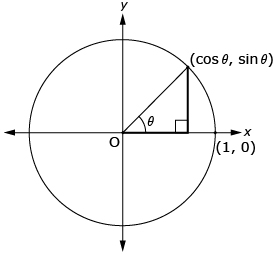In Try This 3 you may have noticed that identities can be used to simplify expressions. A possible solution for Try This 3 is shown in Simplifying a Trigonometric Expression.
In Try This 3 you may have noticed that identities can be used to simplify expressions. A possible solution for Try This 3 is shown in Simplifying a Trigonometric Expression.
If you would like to see another example of using trigonometric identities to simplify expressions, read “Example 2” on pages 293 and 294 of the textbook. If you don't think you need to see another example, move ahead to Self-Check 2.
![]()
So far you have seen how to verify an identity and how to use identities to simplify expressions. In the next section, you will attempt to predict an identity beginning with a geometric representation.
From Module 4, you know that a point where the terminal arm of angle θ intersects the unit circle can be represented by (cos θ, sin θ), as shown in the diagram.

![]() Save your answers in your course folder.
Save your answers in your course folder.